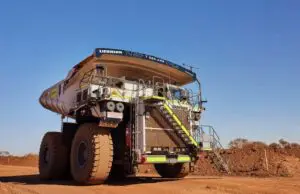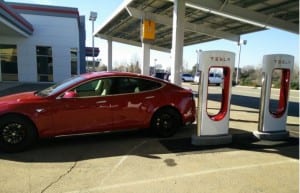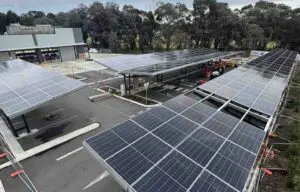 In June, German automaker Daimler AG announced the launch of a new stationary storage business, leveraging its fully owned EV battery maker subsidiary Deutsche Accumotive. The automaker sells batteries to residential and commercial customers in partnership with the German utility EnBW Energie Baden-Wuerttemberg AG.
In June, German automaker Daimler AG announced the launch of a new stationary storage business, leveraging its fully owned EV battery maker subsidiary Deutsche Accumotive. The automaker sells batteries to residential and commercial customers in partnership with the German utility EnBW Energie Baden-Wuerttemberg AG.
Last week, Daimler announced an expansion of its battery business with a 13-megawatt-hour battery storage unit at a recycling plant in Lünen, Germany that uses “second-life” EV batteries — batteries that are too depleted to reliably propel a car, but still have a significant amount of remaining capacity. Daimler claims this is the largest deployment of second-life EV batteries in the world.
The project is a joint venture between Daimler AG, energy services companies Getec Energie and The Mobility House, and the environmental management company Remondis.
Daimler is working with these partners to map out the entire battery chain, including manufacturing, vehicle range and performance, stationary applications in energy markets, and recycling the batteries at the end of their usable life and feeding valuable raw materials back into the production cycle.
The 13-megawatt-hour battery system recently passed certification testing with the ISO, and is slated to begin regular operation early next year, according to Michael Mohnhaupt, president of U.S. operations for The Mobility House, a German startup founded in 2009 to support grid integration of EVs and vehicle batteries.
The Mobility House will own and operate the Daimler battery unit in the wholesale energy market. The revenues are split among all parties.
There is strong demand for high-performing batteries in Germany, where renewable energies are expected to provide 33 percent of the country’s gross electricity consumption in 2015, a large portion of which comes from intermittent renewables like solar and wind. Other countries in Europe, the U.S. and elsewhere are also looking for batteries to help stabilize their grids.
“Car companies don’t know the energy markets well and are scared because energy markets are so diversified. France is different from the U.K., which is different from Germany. Each U.S. state differs from the other,” said Mohnhaupt. “They don’t want to manage all of this on a regional level; they’re used to thinking global.”
“For automakers, the goal is to make electric vehicles cheaper, and one way to make them cheaper is to give the battery a second life,” he continued. “If the battery has a value after its life in the car, you can see additional value instead of dismantling it and paying someone for doing it.”
Automakers get to know the electric grid
Three or four years ago, car companies were concerned that EV batteries wouldn’t even last the life of their eight-year warranty, said Mohnhaupt. Now, having conducted more testing, Daimler estimates that the Lünen battery plant can operate efficiently for at least another 10 years.
Car companies are getting a lot more familiar with the electric grid. “Trust me, five years ago, no one in the auto industry knew anything about it,” said Simon Ellgas, senior advanced technology engineer at BMW of North America.
But that’s changed, said Ellgas, who spoke last month at Greenbiz’s Verge conference. Electric-vehicle manufacturers are actively exploring ways to use second-life batteries — and increasingly, new batteries — as a solution for low-cost grid energy storage.
In June, Nissan became the first EV maker to move beyond pilot-testing second-life batteries with the launch of a full-scale commercial business alongside the California-based startup Green Charge Networks. The same month, General Motors announced a new project testing used Volt batteries. And this week, Daimler announced its new battery project.
For BMW, the latest breakthrough is new data showing that its used batteries can perform reliably in demand response events. The preliminary results come from an 18-month pilot project in partnership with Pacific Gas & Electric.
BMW’s second-life batteries respond to 26 DR events
Under the program, PG&E manages 100 kilowatts of demand from BMW, made up of repurposed BMW Mini E batteries in a stationary unit and a charging program for up to 100 BMW i3 vehicles.
As in a typical demand response event, PG&E sends BMW an alert when there’s a shortage of electricity on the grid. BMW then sends a signal to each vehicle and pauses charging to reduce load. In this case, the vehicle batteries do not push any electrons onto the grid.
If the vehicles aren’t able to respond, either because they’re not plugged in or the customer declines to participate, the second-life battery system, located at BMW’s Mountain View office, kicks in to reduce load.
Since July, PG&E has sent BMW 26 demand-response events, and the automaker delivered on all of them. Depending on the time of day, the vehicles met between 10 percent and 75 percent of the capacity needed. So in every case, the system relied on the second-life batteries.
“The system is performing very strongly, and we’re learning a lot about how we want to modify a program structure to make this a larger-scale program,” said David Almeida, principal program manager of electrification and EVs at PG&E, speaking at Verge.
Under the current setup, PG&E pays BMW for its demand-response services, and the automaker transfers the payment on to the customer. Ellgas expects participating customers to make roughly $540 over the course of the 18-month pilot. So by participating in smart charging, an EV owner could expect to recoup the premium they paid for purchasing the car over its lifetime.
“We want to offset additional costs to make EVs more affordable — that’s the overall mission,” said Ellgas.
How much does a used battery cost?
While there’s money to be made using EV batteries in energy markets, savings ultimately depend on how affordable the second-life battery packs are. Right now, that remains a big open question.
“No one has a reworked battery cost,” said Dan Bowermaster, program manager for electric transportation at EPRI, recently told GTM.
Ellgas insists that automakers have an advantage over dedicated battery manufacturers. “If the auto industry is good at anything, it’s economies of scale and squeezing cost out of a system,” he said.
Arcady Sosinov, CEO of FreeWire, told GTM this spring that his startup is buying repurposed Nissan batteries for $100 per kilowatt-hour. Automakers, however, have been reluctant to reveal pricing.
Car manufacturers are still testing how well second-life batteries perform in various grid applications. They also have to come up with new processes for removing, testing and reconfiguring the batteries before putting them in the field.
Getting it right will offer a lucrative opportunity. Tesla expects up to 90 percent of its energy storage business will be selling large Powerpack batteries for grid use, as opposed to the consumer-facing Powerwall.
“We want to get a foot in the door of this market,” said Ellgas. “We are also looking into using new battery packs for stationary storage applications.”
Source: Greentech Media. Reproduced with permission.










